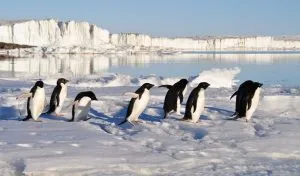Macaroni penguins (Eudyptes chrysolophus) are a penguin species native to Antarctica and several subantarctic islands. These penguins are distinctive for their yellow crests of feathers on their heads, which give them their name.
In this article, we’ll uncover 15 fascinating facts about macaroni penguins, from what they eat and breeding behavior, to penguin divorces and how they were named after fashionable Englishmen.
1. They live in Antarctica, sub-Antarctic islands, and parts of South America
The Macaroni Penguin breeds in southern Chile, the Falkland Islands, the Antarctic Peninsula, and many sub-Antarctic islands.
They are circumpolar and outside of breeding season have been spotted near Australia, Brazil, New Zealand, and Argentina1 (source: IUCN). They don’t return to land during winter and can spend 6 months at sea.
The largest populations can be found at Isles Crozet (2.2m pairs), Kerguelen (1.8m pairs), Heard Island (1m pairs), South Georgia (1m pairs), and Marion Island (290,000 pairs).
This graphic shows the distribution of penguin species across the southern hemisphere (taken from our guide to where penguins live).
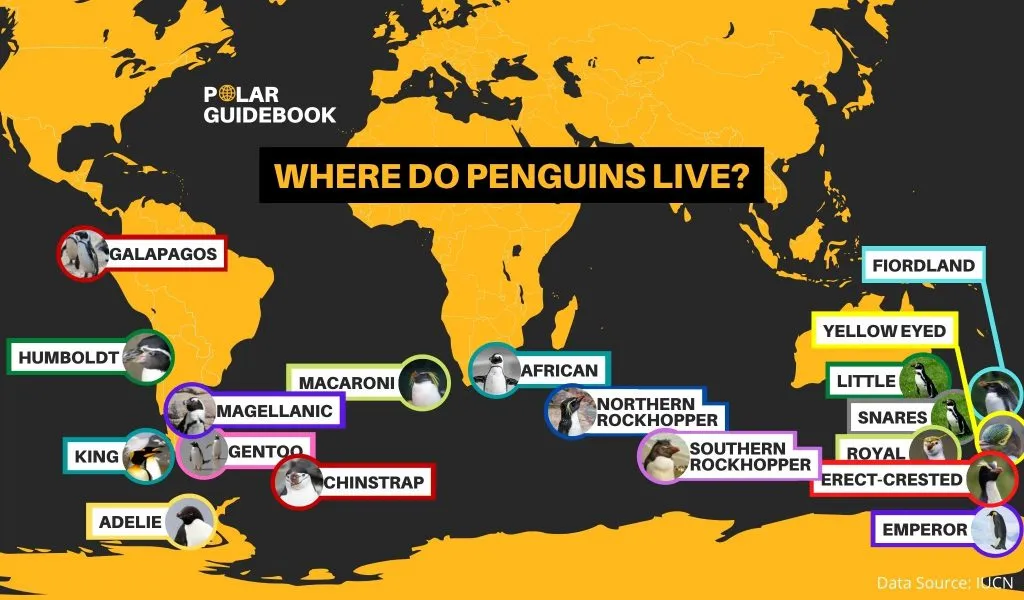
2. They have a yellow crest to attract potential mates
Macaroni penguins have a unique yellow crest on their heads, similar patterns can be seen on other crested penguins. The yellow color is to attract a mate by demonstrating that they are healthy enough to afford to compromise their camouflage2 (source: D. T. Ksepka, American Scientist).
Penguins with the most extravagant yellow feathers are the most desirable to mates3 (source: D.B. Thomas, et al., Journal of the Royal Society, Interface Vol. 10, Issue 83, 2013).
Unlike most other birds which gain unique feather colors from the food in their diet, studies have found that the yellow pigment synthesized by penguins is unique among birds4 (source: D.B. Thomas, Journal of the Royal Society Interface, Vol. 10, Issue 83, 2013).
3. They were named after fashionable Englishmen
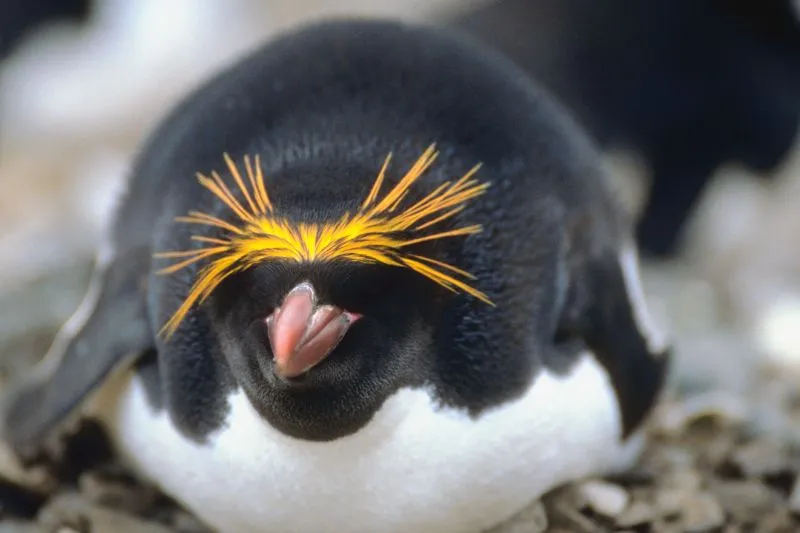
Macaroni penguins were first discovered in 1837 by German naturalist Johann Friedrich von Brandt who was visiting the Falkland Islands.
Their scientific name is Eudyptes chrysolophus, with Eudyptes meaning “good diver” and chrysolophus meaning “golden crest”5 (source: Wikipedia).
The name ‘Macaroni penguin’ comes from English sailors who nicknamed them after Macaronis fashionable 18th-century Englishmen who wore caps with yellow feathers. You might recognize them from the children’s song Yankee Doodle in which the final two lines read “stuck a feather in his cap, and called it macaroni”.
4. Macaroni penguins have a lifespan of 15-20 years in the wild
The lifespan of a macaroni penguin in the wild is estimated to be between 15-20 years old. On average, penguins have a lifespan of around 20 years so this is about average.
In captivity, penguins can live for much longer. Typically, penguins in zoos or aquariums live to around 30 years old. However, there have been documented cases of penguins living to 40 in captivity.
5. They can dive as deep as 90m
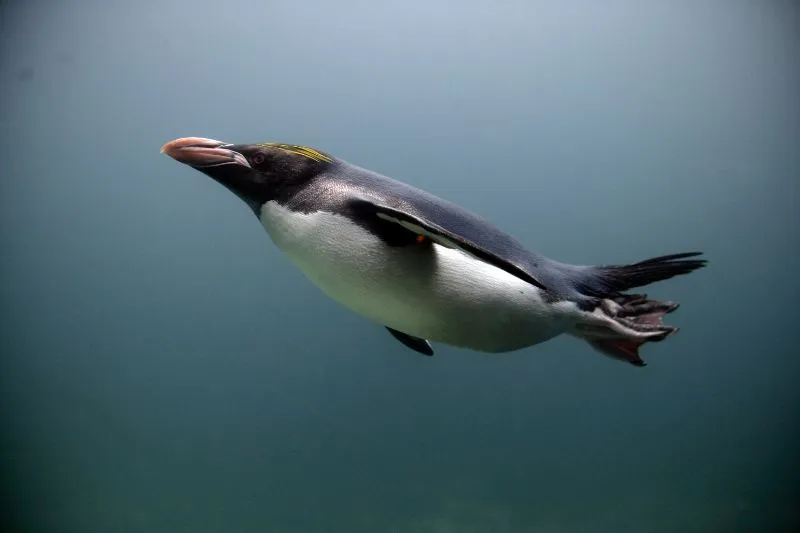
Penguins may spend around 75% of their day-to-day life in the ocean and use it as a hunting ground for catching prey6 (source: S. Moss, Do Birds Have Knees, 2016) so they have adapted to be strong swimmers (one of the reasons why they can’t fly!).
Macaroni Penguins can dive as deep as 90m, although the average is between 15-60m. The majority of dives by Macaroni Penguins are shorter than 2 minutes7 (sources: Journal of Experimental Biology and Penguins: Natural History and Conservation).
6. There are just 26,498 macaroni penguins left
Estimates of the number of macaroni penguins in the wild suggest there are around 26,498 mature birds. This makes them one of the smallest penguin species by population. For comparison, the total number of penguins left in the wild is thought to be between 30-31 million.
Their population has been in rapid decline over the past three generations so they have been rated as vulnerable by the IUCN. Vulnerable is one level above endangered on their scale.
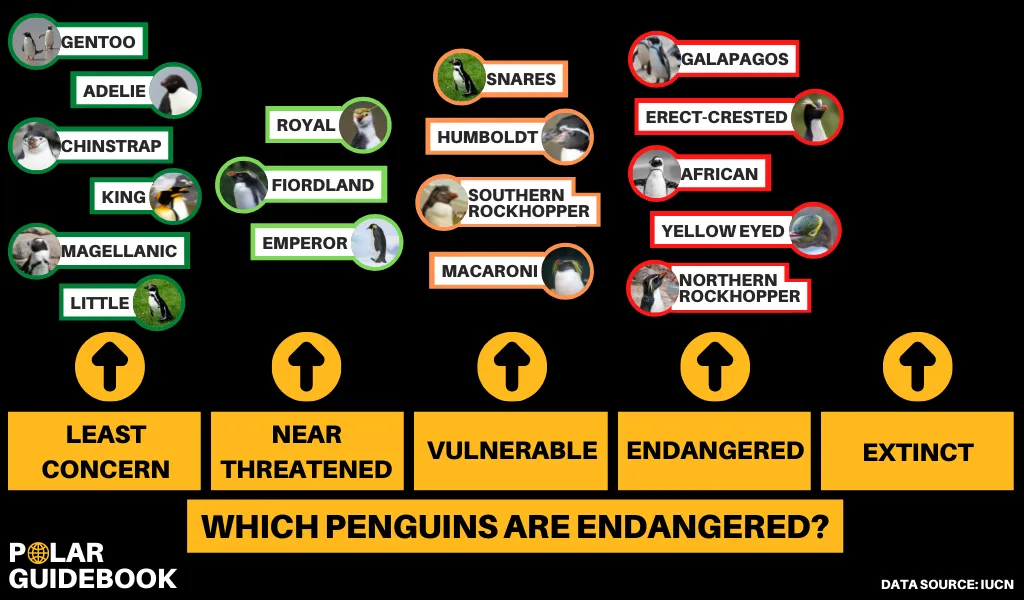
The main reasons for their population decline are not fully understood but it’s likely to be climate change and it’s impacts on their ecosystem.
The growth of Antarctic fur seals in the area has also impacted macaroni penguins as this has meant there is more competition for food and the seals sometimes prey on the penguins too8 (source: IUCN).
7. They lay two eggs but discard one
When breeding, macaroni penguins will typically lay two eggs. However, the first egg is usually much smaller than the second and is often discarded by the mother who may refuse to incubate it or push it out of the nest.
Instead, she will put all of her focus on incubating the second, larger egg. This is common among all crested penguin species.
The purpose of this strategy has been debated by scientists for many years, but the most likely reason is that the first egg is ovulated whilst the mother is still out at sea so she cannot yet fully commit herself to the egg whilst swimming for days on end. This is why the first egg is always smaller and doomed from the outset9 (source: National Geographic).
8. They eat more food than any other marine birds
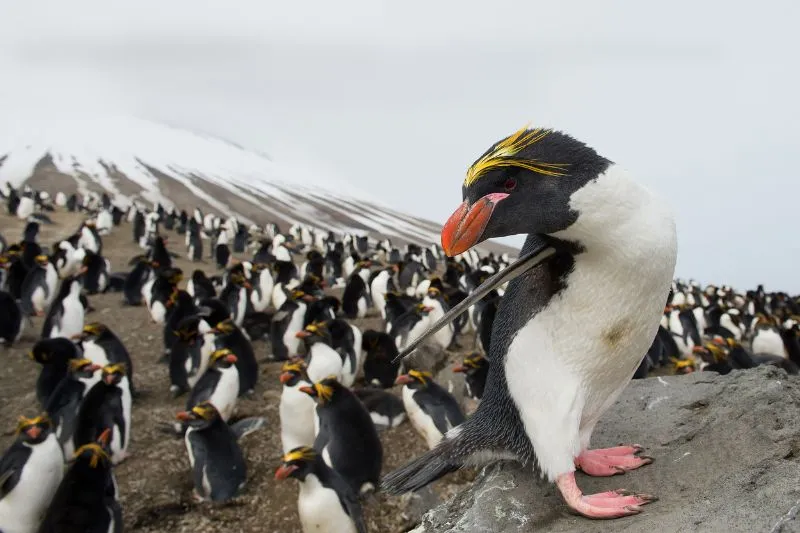
They are carnivores and their diet consists of crustaceans and fish with some squid too.
For those at more southerly latitudes, such as near South Georgia, Antarctic krill makes up the majority of their diet. Whereas those more northerly and easterly opt for other types of krill such as Thysanoessa Gregaria as well as a greater proportion of lanternfish10 (source: Penguins: Natural History and Conservation).
As a total species, Macaroni Penguins consume the most food, that’s compared to all marine birds, not just the other penguins. It’s estimated that they consume more than 8 million tons of prey per year, mostly krill11 (source: C.M. Waluda, et al., Marine Ecology Progress Series, Vol. 466, 2012).
They catch most of their prey by diving deep below the surface and swallowing their prey whole. See our full article to find out more about how penguins eat.
Changes in the climate, as well as krill fishing practices, are impacting the supply of krill in the territory of Macaroni penguins and it’s predicted that this could have a knock on effect to the population of the penguins if it continues12 (source: K. A. Cresswell, et al, Polar Biology, vol. 31, pp. 641–649, 2008).
9. Macaroni penguin chicks purposefully swallow stones
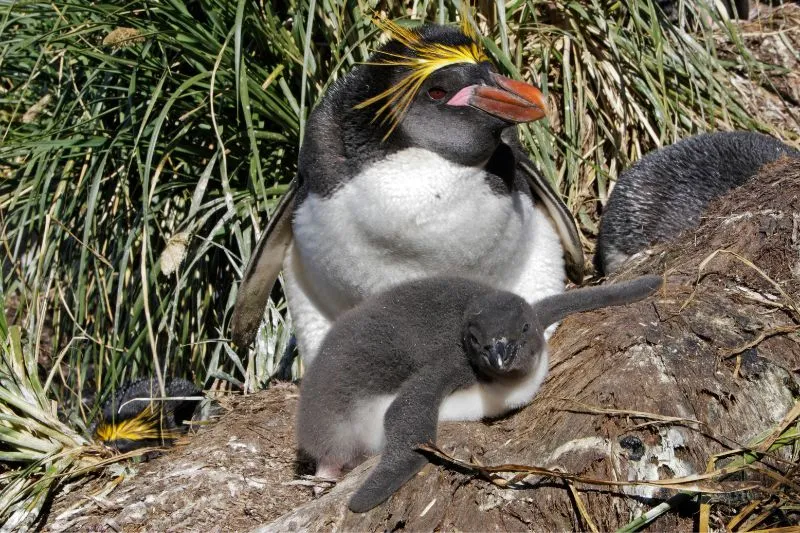
Macaroni penguin chicks have been observed swallowing stones that are between 10-20mm in diameter. In some instances, the parents were present so it’s assumed that the stone swallowing serves a purpose.
Scientists have proposed several theories about why penguins swallow stones. In the case of Macaroni penguins, the most likely reason is that the stones aid with the trituration of crustaceans which tend to have a hard exterior and are an important part of their diet13 (source: M.S. De Villiers and P.J.N. De Bruyn, Stone-Swallowing By Three Species Of Penguins, 2004).
Other penguin species, such as the emperor penguins, may swallow them to decrease buoyancy, helping them dive deeper into the ocean to forage for food.
10. Their main predators of macaroni penguins are orcas and leopard seals
Macaroni penguins spend most of their lives at sea but this is also where their biggest predators are. The main predators of Macaroni penguins are orcas (killer whales) and leopard seals.
Antarctic fur seals occasionally prey on penguins, but prey competition is more of a problem with them since both seals and penguins have a similar diet.
Macaroni penguins have no natural terrestrial predators, however, whilst on land, their eggs, and young or vulnerable chicks may be preyed upon by gulls, skuas, giant petrels, and sheathbills.
Introduced predators on sub-Antarctic islands, such as cats, mice, and rabbits, do prey on penguins but it’s thought that they aren’t a large threat14 (source: IUCN).
11. They are medium-sized penguins at about 70cm tall
Macaroni penguins are 27” (70cm) tall which is about average for a penguin. They can weigh anywhere between 3.5-6.5kg (7.75-14lbs)15 (source: Animal: The Definitive Visual Guide).
Males tend to be around 15-20% bigger than females and their weight can vary throughout the year
The below graphic shows how Macaroni penguins compare to the size of other penguins.
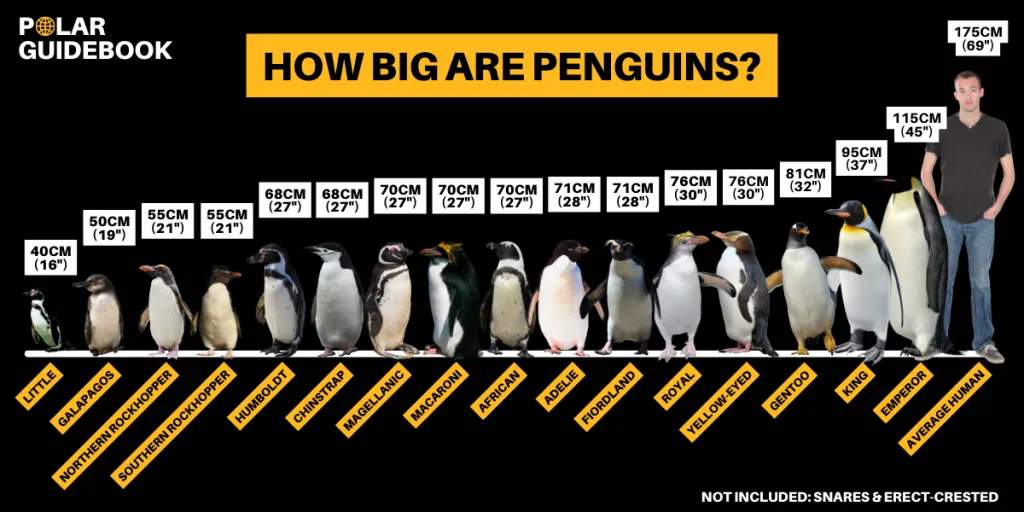
12. They are monogamous but do not mate for life
Penguins are monogamous which means that they will have only one partner per breeding season, however, this doesn’t mean they stay with the same partner for life.
The chance of a macaroni penguin staying with the same mate for two consecutive years has been measured at about 71-79% which is about average for a penguin. However, the chances of them staying together for three years in a row is just 50%16 (source: T.D. Williams, The Penguins: Spheniscidae, 1995).
Pairs will usually choose the same nesting site from year to year. When pairs do choose new mates even though there old mate was present (this is known as a penguin divorce), in 69% of cases it’s the male that keeps the nest17 (source: T.D. Williams, The Penguins: Spheniscidae, 1995).
13. Males and females share parenting duties until they are ready for creche
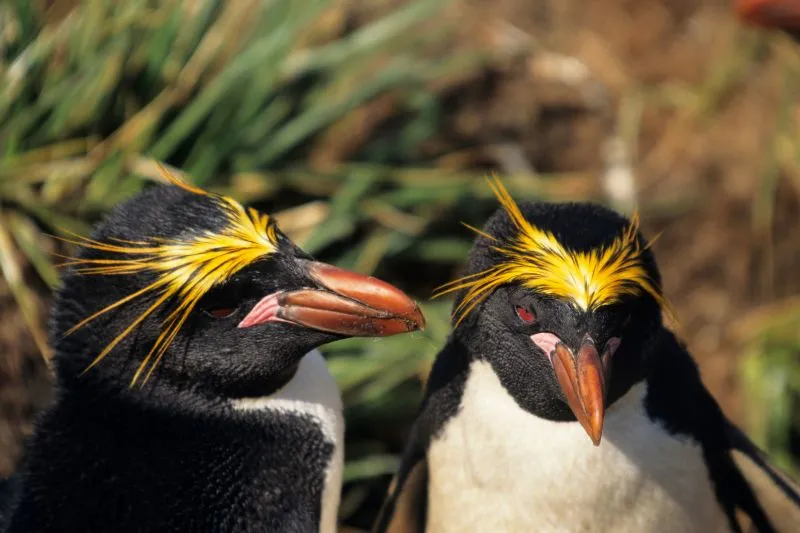
Right from the outset, parenting duties are shared, starting with incubation. Males and females take turns incubating the eggs whilst the other parent forages for food at sea. They will have to fast considerably during this period and both adults can lose 36–40% of their body weight18 (source: T.D. Williams, The Penguins: Spheniscidae, 1995).
Once the chicks are born, the male macaroni penguin takes charge of caring for and protecting the young whilst the female makes short foraging trips to bring back food every 1-2 days.
After around 25 days, they can be left in large groups with other chicks (called a creche) while both parents forage for food.
14. Macaroni penguins can be in same-sex couples

Like many other penguins, Macaroni penguins have been known to engage in same-sex relationships. This happens in the wild and captivity.
Some of the most famous gay penguins are two macaroni penguins, Frankie and Vinnie, at Folly Farm in Wales19 (source: Western Telegraph).
Same-sex couples can be identified as they are seen allopreening (the scientific name for a penguin kiss).
They are known to try and steal eggs from straight couples or sometimes they try to hatch rocks. Read our full article on whether penguins can be gay to find out how zoo keepers are responding.
15. They can drink salt water thanks to a special salt gland
Macaroni penguins, like all other species, spend most of their lives at sea where they can ingest high levels of salt water when consuming their prey.
Since their kidneys are not very efficient at processing salt, they have a special salt gland (also known as a superorbital gland) at the top of their skull, near their eye, to help remove salt from their blood.
The salt is excreted through their nostrils by sneezing or shaking their head20 (source: Britannica).
Macaroni penguins have a relatively large salt gland compared to most other species. This is because they have a higher percentage of marine invertebrates in their diet which are very salty compared to fish21 (source: S.L. Hauserman, et al., The Smithsonian Institution).


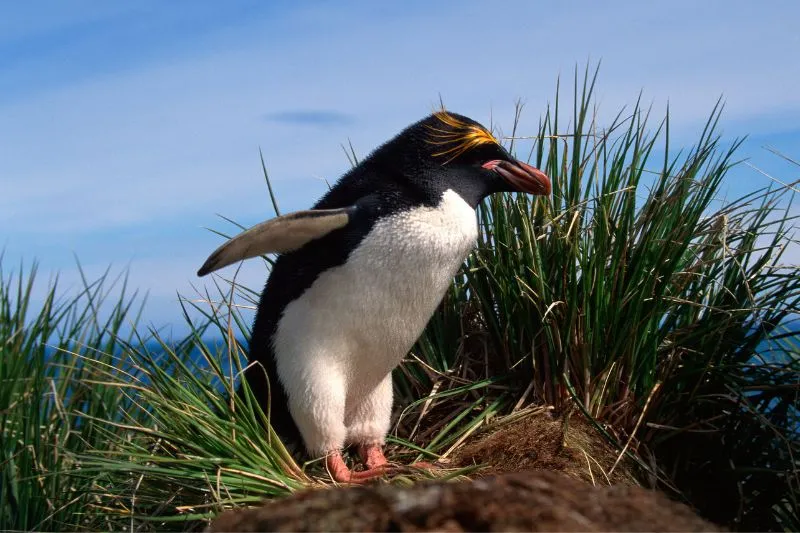
![Read more about the article 14 Magnificant Facts About Magellanic Penguins [#9 Will Surprise You!]](https://polarguidebook.com/wp-content/uploads/2023/01/Magellanic-penguins-group-300x200.jpg)

